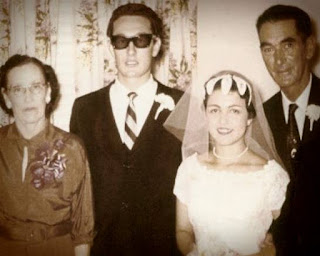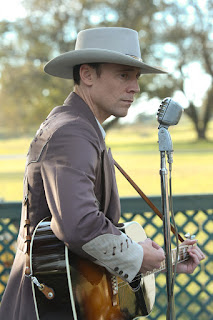As happens every year about this time, the fever’s spreading – the Winter Dance Party fever. Immediately on the heels of Monday night’s first-in-the-nation caucuses, Clear Lake will put on its finest as it welcomes people from around the world for a one-of-a-kind celebration of the early days of rock and roll. That includes commemorating the deaths of three blossoming personalities – Buddy Holly, Ritchie Valens and The Big Bopper – whose airplane crashed that fateful night near Clear Lake. Indeed, their memories and music will be a big part of the event that starts next Wednesday at the legendary Surf Ballroom. Source: globegazette.com
The former Mrs. Bowie says that she and David Bowie met through their mutual friend, record executive Dr. Calvin Mark Lee. In an interview with The Mirror, Angela Bowie actually recalls the first time she and Bowie slept together, when she was just a teenager:
"I remember exactly where and when David Bowie and I first slept together. It was in London in the summer of 1968 after an evening at the Speakeasy – the night King Crimson celebrated their new recording contract and Donovan got up and sang Buddy Holly songs with them. David came back to my little room above the Nomad Travel Club in Paddington. He was pretty drunk and we were both pretty exhausted when we fell into my little bed together." Source: heavy.com
BUDDY HOLLY: BABY I DON'T CARE / IT'S NOT MY FAULT (refurbished sound).
-Carl Bunch (drummer of Buddy Holly's band during the Winter Dance Party Tour in 1959): You can't really understand how bad the circumstances were under which we lived. We had broken down bus, after broken down bus, often without heaters, to be confined in for what seemed like forever between gigs. There were no superhighways back then. It was rare to get to stay in a hotel; at least it felt rare. I spent most of my time with Ritchie Valens. He knew I was more than just a little impressed with him as a performer. Ritchie talked about Donna a lot and got ribbed quite a bit about not going with the groupie girls after the gig. Ritchie, Bopper, and Buddy were all one-woman men. No matter what the temptation, they went to their rooms, when we had one, and not to the parties. We opened the tour at George Devine’s Ballroom in Milwaukee on the 23rd of January. I remember very clearly Buddy asking just as we pulled up, "What time is this eight o'clock gig going to get started?" At George Devine’s Ballroom in Milwaukee we were over an hour late due to problems with the bus and the weather. We had to set up on stage in front of an angry crowd and we ended up starting about two hours after we were supposed to. I was an absolute nervous wreck. Buddy kept talking to me backstage, telling me I'd be just fine. He said, "You're one of the Crickets now."
Dion came out and did his latest hits, "Teenager In Love," "Runaround Sue," and the rest. The audience loved him. The Big Bopper absolutely sent the crowd into a frenzy with “Chantilly Lace.” Ritchie’s “La Bamba” had just hit number one on the charts and he whipped them into a frenzy on top of a frenzy with his performance. But when Buddy came out, it was almost like God had walked out on the stage. Buddy was a Christian and an honest man.
-Lance Monthly: In one of the Buddy Holly biographies it was theorized that Buddy fathered a child out of wedlock, which has prompted a lot of talk and speculation. Do you have any information?
-Carl Bunch: I've never before heard a single word about it and I don't believe it. It's totally out of character for Buddy to have been sexually involved with anyone but Maria Elena. That's one of the things that stood out so much to me on the tour. Buddy could have had any of hundreds of beautiful girls or women, but chose not to cheat on his wife, period. I can't imagine why anyone would spread such a vicious rumor about such a nice guy. Buddy was a Christian. He did not believe in adultery. Source: www.musicdish.com and musicdish.com/mag
Friday, January 30, 1959: About thirty miles west of Davenport, the Winter Dance Party bus stopped providing heat altogether. All nine heaters on the converted school bus had frozen. It would take several hours for them to thaw and be cleaned out. As mechanic Martin Young began defrosting the heaters, the singers scattered throughout the eastern Iowa town of about 2,100. Buddy Holly and several others remained in the Gaul Motor Co.'s showroom, many sitting on a bench near some new 1959 Edsels. Holly pulled a bucket-type tractor seat from a display and plopped down on it. “I’m a reindeer salesman,” he quipped to the amusement of his friends.
Ritchie Valens led another group across the alley to the tiny Meet and Eat Cafe, where Esther Wenck and Betty Murray were serving up hamburgers and hot beef sandwiches to a packed lunchtime crowd. Even though the cafe had just a handful of tables and a few seats at the counter, a jukebox was squeezed in against one wall. Valens stood at the jukebox and asked waitress Wenck: “Would you like to hear the song I made famous?” Says Wenck: “I thought he was kidding. I said yes.” Several Tipton residents then were treated to an impromptu performance as Valens sang along to “Donna.” “I still thought he was goofin’,” Wenck notes. “I still didn’t think it was him.”
The bus was late arriving in Fort Dodge. “We were worried,” says Dick Derrig, an assistant manager at the Laramar Ballroom. Eddie Simpson, a fan who attended the Laramar concert: “I can remember when they announced Buddy Holly and he stepped out on the stage. He had been standing back in the backdrop and everybody went nuts when he started singing.” Simpson and two friends stopped to use the basement restroom when they spotted the singers sitting in a booth: “They were stars, but they were as common as could be. They just sat and talked to us.” Holly called his pregnant wife in New York. “Buddy would call from the tour and say how unhappy he was,” Maria Elena later told the Chicago Tribune: “I’d say, ‘Why don’t you come home?’ He’d say, ‘you know me. I have to finish.’ Besides, we needed the money.” Bill McCollough, a local disc jockey at KWMT who was to emcee the Laramar show started a conversation with Holly: “He was complaining about the bus, he was going to catch his death of cold. I had been taking some flying lessons.” “Could you call somebody and get us a plane?” Holly asked. —"The Day the Music Died: The Last Tour of Buddy Holly, the Big Bopper, and Ritchie Valens" (1997) by Larry Lehmer











































